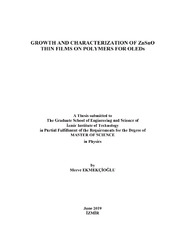Please use this identifier to cite or link to this item:
https://hdl.handle.net/11147/7337| Title: | Growth and characterization of ZnSnO thin films on polymers for OLEDs | Other Titles: | OLED’ler için polimerler üzerine ZnSnO ince filminin büyütülmesi ve karakterizasyonu | Authors: | Ekmekçioğlu, Merve | Advisors: | Aygün Özyüzer, Gülnur | Keywords: | OLEDs Indium tin oxide Thin films Polymers |
Publisher: | Izmir Institute of Technology | Source: | Ekmekçioğlu, M. (2019). Growth and characterization of ZnSnO thin films on polymers for OLEDs. Unpublished master's thesis, İzmir Institute of Technology, İzmir, Turkey | Abstract: | The use of flexible organic light-emitting diodes (OLEDs) in smartphones and
televisions with inclined screen shows significant improvements in commercial
applications. Recently, flexible OLEDs have been used in lightweight, portable,
wearable and even deformable screens, sensors as well as solid-state lighting
applications. Under favour of these applications, remarkable developments are observed
in the production of flexible electronics. The advantages of OLEDs according to the
existing liquid crystal display (LCD) technology are self-emission capability, wide
viewing angle, fast response time, simple structure, and low driving voltage. Highly
conductive and transparent anodes are required for efficiency and uniform light emission
in OLEDs. Indium tin oxide (ITO) which is one of the most promising anodes among
transparent conductive oxides (TCO), has superior electrical and optical properties such
as ~85% high transmittance at the visible region and ~104 Ω−1 cm−1good conductivity.
The reason is due to the bandgap range of about 3.70 eV. Zinc tin oxide (ZnSnO or ZTO)
is another TCO commonly used for many applications in the literature. Alternative
anodes eliminate the use of ITO due to the absence of indium element so that highly
desirable. In this thesis, ZTO is used as anode instead of ITO thin film and the eligibility
of ZTO as an anode in OLED production is explored. The advantages of the optimized
ZTO thin film according to the ITO are that is abundant on earth, has better performance,
has low surface resistance, has less surface roughness, is capable of being produced as
an anode in OLEDs. In this thesis to be successful, at the first stage ZTO thin films have
grown on soda lime glass by magnetron sputtering, then ZTO and ZTO/Ag/ZTO
multilayer thin films respectively have been deposited on flexible Polyethylene
terephthalate (PET) and Polyimide (PI) substrates by magnetron sputtering method. In
this way, the best coated thin films have been investigated using spectrophotometry,
energy-dispersive X-ray spectroscopy (EDS), scanning electron microscopy (SEM), Xray
diffraction (XRD) and Raman spectroscopy. Eğimli ekranlara sahip akıllı telefonlarda ve televizyonlarda esnek organik ışık yayan diyotlar (OLED’ler) kullanılması, daha çok ticari uygulamalarda önemli gelişmeler göstermektedir. Son zamanlarda, esnek OLED’ler, hafif, taşınabilir, giyilebilir ve hatta deforme edilebilir ekranlarda, sensörlerde ve ayrıca katı hal aydınlatma uygulamalarında kullanılmaktadır. Bunun sonucunda esnek elektronik üretiminde dikkat çekici gelişmeler gözlemlenmiştir. OLED’lerin mevcut sıvı kristal ekran (LCD) teknolojisine gore avantajları, kendi kendine emisyon yetisine sahip olması, geniş görüş açısı olması, hızlı tepki süresi olması, basit yapı ve düşük çalışma voltajıdır. OLED’lerde verim ve homojen ışık emisyonu için, yüksek iletken ve şeffaf anotlar gereklidir. Saydam İletken Oksitler (TCO) ince filmler arasında en umut verici anotlardan olan indiyum kalay oksit (ITO) görünür bölgede ~%85’lik yüksek geçirgenlik ve ~104 Ω−1cm−1’lik iyi iletkenlik gibi üstün elektriksel ve optiksel özelliklere sahiptir. Bunun nedeni ise yaklaşık 3.70 eV geniş bant aralığından kaynaklanmaktadır. Çinko kalay oksit (ZnSnO veya ZTO) literatürdeki birçok uygulama için yaygın olarak kullanılan bir başka TCO’dur. İndiyumun azlığından dolayı ITO kullanımını ortadan kaldıran alternatif anotlar oldukça arzu edilmektedir. Bu araştırmada ITO ince filmi yerine anot olarak ZTO kullanılmakta ve ZTO’nun OLED üretiminde anot olarak uygunluğu araştırılmaktadır. Optimize edilmiş ZTO ince filmin ITO’ya göre avantajları yeryüzünde bol miktarda bulunması, daha iyi performans göstermesi, düşük yüzey direncine sahip olması, daha az yüzey pürüzlülüğü olması ve OLED’lerde anot olarak üretilebilme kabiliyetine sahip olmasıdır. Bu tezde, amacımıza ulaşmak için ilk olarak ZTO ince filmlerin soda kireç cam üzerine mıknatıssal saçtırma yöntemiyle büyütüldü, sonra sırasıyla ZTO ve ZTO/Ag/ZTO çok katmalı ince filmler esnek polietilen tereftalat (PET) ve Poliimid (PI) alttaşlar üzerine mıknatıssal saçtırma yöntemi ile kaplanmıştır. Böylece, en iyi kaplanan ince filmler, spektrofotometri, enerji dağılımlı X-ışını spektroskopisi (EDS), taramalı elektron mikroskobu (SEM), X-ışını kırınımı (XRD) ve Raman spektroskopisi kullanılarak incelenmiştir. |
Description: | Thesis (Master)--Izmir Institute of Technology, Physics, Izmir, 2019 Full text release delayed at author's request until 2020.02.23 Includes bibliographical references (leaves: 55-59) Text in English; Abstract: Turkish and English |
URI: | https://hdl.handle.net/11147/7337 |
| Appears in Collections: | Master Degree / Yüksek Lisans Tezleri |
Files in This Item:
| File | Description | Size | Format | |
|---|---|---|---|---|
| 10147140.pdf | MasterThesis | 5.12 MB | Adobe PDF |  View/Open |
CORE Recommender
Page view(s)
290
checked on Jul 22, 2024
Download(s)
434
checked on Jul 22, 2024
Google ScholarTM
Check
Items in GCRIS Repository are protected by copyright, with all rights reserved, unless otherwise indicated.